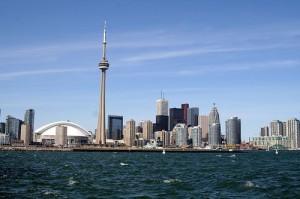
A view of Toronto, named one of the most walkable cities in the Great Lakes region. Photo: ilkerender (flickr)
Three of Canada’s five most walkable cities are in the Great Lakes region, according to an organization that evaluates how easy it is to get around on foot.
Walk Score is a privately-held company that operates a website that provides walkability rankings. For the first time it has ranked Canada’s 10 largest cities using collected data.
Walk score measures walkability of different addresses by looking at nearby amenities such as grocery shopping, schools, cafes, pharmacies and more, said Aleisha Jacobson, data collector of Walk Score.
Neighborhoods ranked high by the score are considered walkable, with benefits to health, environment, finances, and communities.
Out of the top five Canadian cities ranked by Walk Score, three rest in the Great Lakes watershed. Toronto received an average score of 71, while Montreal had an average score 70 and Mississauga, located west of Toronto on Lake Ontario, had an average score of 58. Scores are averaged out after taking data from addresses throughout the area.
Toronto, Canada’s second highest ranked city, features unique coffee cafes, parks, and gardens, has a sense of tourism with websites like Tripadvisor and Lonely Planet advertising summer festivals and the famous CN Tower. These amenities add to the walkability of the city, increasing the average score.
Most walkable communities in Great Lakes states and provinces View Great Lakes Watershed Walkscore in a larger map
Some local shop owners say they have seen an increase in business in the last year. This increase in business helps to promote the walkability score as well. The data used to come up with a cities ranking is affected by population, economy, amenities and transit.
Alternative Grounds Coffee House and Roastery, a certified organic processor and fair trade roaster, has welcomed the growing foot traffic.
“We had construction on our street for almost three years, repairing sewer and gas lines and things like that,” Said Kevin Walters, of Alternative Grounds Coffee House and Roastery. “It’s been done for about a year and the increase in customers is great. The construction has left wider, improved sidewalks so that lots of people have redeveloped our street. Our street is great for pedestrians.”
Walters, also a resident of Toronto, enjoys the area for walking around. The finished construction has left improved pavements with planted trees and gardens to allow water drainage when walking on rainy days.
“A plus to the area is that it’s also really great to bike, people really like to bike around,” said Joanna Moon, who lives in Toronto.
It is not just residents who enjoy the streets and sidewalks, but realtors and future residents are using Walk Score to help determine the ideal place to live.
Realtors work with people who want to relocate to the area, said Toronto Real Estate Board’s president, Ann Hannah. Clients and realtors will use Walk Score to help assess certain qualities of areas.
“I would put the age group under 40 as very interested, plus those people who are keen on environmental issues would seek this site (Walk Score) out,” said Hannah. “Older clientele who have been living outside the Greater Toronto Area, but want to relocate, would certainly be interested as they are moving back for better transportation.
Hannah said other realtors also acknowledge that certain clients look for school areas that offer walking and biking.
Realtors in the area assist clients to look for ease of transportation and access, schools, access to shopping, depending on the clients family size and age.
“Over that they will look for transportation, transportation highways, recreation such as golf courses and facilities for sports and dance, ballet etc,” said Hannah.
“So much of their considerations are surrounded by the needs of families,” Hannah said. “Younger clients who are unmarried usually want to be where “all the action is” close to downtown or easy access to the area for restaurants etc.”
Other areas rated by Walk Score around the Great Lakes Basin include the 8 states bordering the lakes including Wisconsin, Minnesota, Michigan, Illinois, Ohio, Indiana, New York and Pennsylvania.
Here are the top five most walkable U.S. cities in Great Lakes states and their scores as ranked by Walk Score:
Wisconsin
– West Allis 61
– Milwaukee 61
– Wauwatosa 60
– LaCrosse 60
– Racine 56
Minnesota
– Minneapolis 69
– St. Paul 62
– Hopkins 61
– St. Louis Park 58
– West St. Paul 56.
Michigan
– Hamtramck 69
– Ferndale 64
– Madison Heights 63
– Mount Pleasant 61
– Birmingham 60
Illinois
– Oak Park at 78
– Evanston 75
– Chicago 74
– Elmwood Park 70
– Skokie at 67
Ohio
– Lakewood 68
– Cleveland Heights 64
– Norwood 64
– Athens 63
– Cincinnati 59
Indiana
– East Chicago 62
– Highland 56
– Logansport 54
– West Lafayette 53
– Vincennes at 53
New York
– New York with a score of 85
– Mineola 78
– Port Chester 78
– Lynbrook 74
– Mount Vernon 73
Pennsylvania
– West Chester at 79
– Lancaster 79
– Philadelphia 74
– Easton 70
– State College at 70
Very informative article, I had no idea about walkable cities and was surprised on some of the cities.